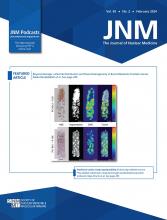REPLY: We read with great interest the letter from Dr. Caobelli, which referred to our recent article in The Journal of Nuclear Medicine on using bone scintigraphy to monitor patients with amyloid transthyretin–related (ATTR) cardiac amyloidosis (CA) under tafamidis therapy (1).
For a long time, ATTR CA was a disease for which there was no effective therapy, making it frustrating for the treating physicians, particularly in light of the morbidity and mortality of the disease (mean life expectancy of ∼2.5 y for certain hereditary forms and 3.6 y for wild-type ATTR CA without therapy) (2,3). The community was therefore all the more enthusiastic about the recent introduction of an effective therapy that could at least halt disease progression, as demonstrated in the ATTR-ACT trial (4). As pointed out by Dr. Caobelli, we observed a reduction in cardiac 99mTc-3,3-diphosphono-1,2 propanodicarboxylic acid (99mTc-DPD) accumulation in most of our patients under ongoing tafamidis therapy, a finding that was unexpected for us. Including our study, there are now several publications that support this observation (1,5–7), but the reason for the decreased accumulation of bone-avid tracers in the heart is still unclear. To our knowledge, it is still not fully understood why bone-avid tracers bind to the heart of patients with ATTR CA. One of the most frequently raised theories, which was also mentioned by Dr. Caobelli, is that the tracers bind to microcalcifications that form in the area of amyloid deposits in the heart. This theory is supported, inter alia, by the fact that electron microscopic studies detected these microcalcifications in the heart (referred to in the cited publication as “dust-like calcifications”) (8). Interestingly, they were found not only in the vicinity of amyloid but also in areas where there were no amyloid deposits—a fact that could in a way support the hypothesis of Dr. Caobelli that binding of bone-avid tracers could be more an (early) indicator of active amyloid deposition than of persisting deposits.
Moreover, it could be assumed that a decrease in tracer accumulation in the heart is associated with a decrease in calcifications, but to our knowledge there are no studies on this. It is known from the ATTR-ACT trial that patients undergoing tafamidis therapy, which stabilizes transthyretin, experience a slowing of disease progression compared with placebo therapy. In MRI studies, this is reflected in a stabilization of the extracellular volume (9), whereas in the ATTR-ACT trial there was a less severe deterioration of, for example, the 6-min walk test or the Kansas City cardiomyopathy questionnaire overall summary score (4). In the APOLLO-B trial, in which patients with ATTR CA received either the small interfering RNA-based patisiran (inhibiting hepatic production of transthyretin) or placebo, all patients receiving patisiran showed a reduction in cardiac tracer uptake, whereas none of the patients in the placebo arm did (10). In this context, the idea that uptake of bone-avid tracers to the heart is reduced under tafamidis therapy because microcalcifications form on only fresh and active amyloid deposits is interesting. However, since there is still a lack of data on this, the idea must be classified as (at least in part) speculative. Further considerations as to why the binding is lower relate to a possible reduction in amyloid deposition (11). This hypothesis is supported by the fact that we observed a clinical improvement in the patients with reduced cardiac 99mTc-DPD uptake (1). Furthermore, other researchers, who also saw a decrease in tracer accumulation in the heart on bone scans, observed a decrease in N-terminal pro–brain natriuretic peptide levels and an improvement in, for example, the global longitudinal strain on echocardiography with tafamidis therapy (5).
In our opinion, one of the most important ways to clarify this current mystery could be to perform amyloid-specific imaging. In contrast to cardiac MRI and bone scintigraphy, amyloid-specific PET tracers bind directly to the amyloid (12) and, hence, can visualize cardiac amyloid burden. Using these amyloid-specific PET tracers, it should therefore be possible to investigate whether there is a real decrease in the amyloid load in the heart under tafamidis therapy; however, no such study has been conducted so far to the best of our knowledge (13). If this is not the case, the idea put forward by Dr. Caobelli could certainly provide a potential explanation. Moreover, explaining the mechanism of cardiac binding of bone-specific scintigraphy tracers in patients could shed light on the question of whether they can be used for early detection as well as monitoring of therapy response. In summary, many questions remain unanswered, and research on ATTR CA still represents a highly interesting field for imagers and clinicians alike.
Christoph Rischpler*, David Kersting, Lukas Kessler, Zohreh Varasteh, Peter Luedike, Alexander Carpinteiro, Tienush Rassaf, Ken Herrmann, Maria Papathanasiou
*Klinikum Stuttgart Stuttgart, Germany
E-mail: c.rischpler{at}klinikum-stuttgart.de
Footnotes
Published online Jan. 11, 2024.
- © 2024 by the Society of Nuclear Medicine and Molecular Imaging.
REFERENCES
- Revision received December 6, 2023.
- Accepted for publication December 12, 2023.







